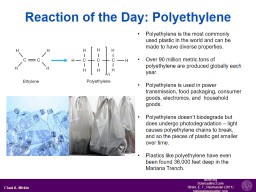

Polyethylene is the most commonly used plastic in the world and can be made to have diverse properties Over 90 million metric tons of polyethylene are produced globally each year Polyethylene is used in power transmission food packaging consumer goods electronics and household goods ID: 1020875
Download Presentation The PPT/PDF document "Reaction of the Day: Polyethylene" is the property of its rightful owner. Permission is granted to download and print the materials on this web site for personal, non-commercial use only, and to display it on your personal computer provided you do not modify the materials and that you retain all copyright notices contained in the materials. By downloading content from our website, you accept the terms of this agreement.
1. Reaction of the Day: PolyethylenePolyethylene is the most commonly used plastic in the world and can be made to have diverse properties. Over 90 million metric tons of polyethylene are produced globally each year.Polyethylene is used in power transmission, food packaging, consumer goods, electronics, and household goods.Polyethylene doesn’t biodegrade but does undergo photodegradation – light causes polyethylene chains to break, and so the pieces of plastic get smaller over time. Plastics like polyethylene have even been found 36,000 feet deep in the Mariana Trench.aiche.orgSciencedirect.comStrom, E. T.; Rasmussen (2011)Nationalgeographic.com
2. Today’s OverviewPolymersAddition Polymerization vs. Condensation PolymerizationCross-Linking Elastomers, Thermoplastics, ThermosetsWhat do these have in common?
3. What are Polymers?Polymer: Chain-like molecule composed of many (poly-) repeating structural units called monomers (-mers).Monomers can be any building block that connects together.Natural Polymers:Rubber, leather, wool, DNA, proteinsSynthetic Polymers:Polyethylene, polypropylene, polyester, nylon, polyvinylchloride
4. Structure of a Polymer (Kevlar)Repeating Unit (Monomer)Contained in BracketsTerminal group:This is where the next monomer can be added.Terminal group.Number of monomers in a polymer chain.
5. Addition Polymerization (Chain-Reaction Polymerization)Double bonds open up to form “radical” unpaired electrons at the end of each chain.Formation of a bond is more stable than unpaired electrons, therefore these continue to build in a chain-reaction.Radical Intermediateethylenepolyethylene
6. Common Addition PolymersPetrucci, Harwood, Herring, Madura, General Chemistry
7. Two molecules join together and often eliminate a small molecule such as H2O.Condensation Polymerization(Step-Reaction Polymerization)
8. Common Condensation PolymersPetrucci, Harwood, Herring, Madura, General Chemistry
9. Cross-Linking Connects Polymer Chains via Covalent Bond Formation or IMFsCovalent bond formation lends properties to polymer chains that are not seen in the chains alone.Example: Isoprene into rubber via vulcanization.Intermolecular forces (hydrogen bonding, dipole interactions, and dispersion forces) Example: Nylon 6,6; KevlarPolymer types, based on these properties:ThermoplasticThermosetElastomerVulcanized RubberKevlar
10. Thermoplastic Polymers Exhibit Temperature-Dependent PropertiesAbove critical temperature, become fluid, or “glassy”.When cooled below critical temperature will retain shape of previous container.Reusable; Can be molded into new forms.Example: Polyethylene bags
11. Thermoset Polymers Exhibit Irreversible Cross-Linking with HeatAbove critical temperature, polymer undergoes irreversible cross-linking reaction.Upon cooling, polymer retains final form.+Involves the formation of a chemical bond!Vulcanization of rubberpolyisoprenesulfur
12. Cross-Linking in Elastomers Allows Reversible StretchingPolymer reorganizes upon application of stress to redistribute force.Weak IMFs broken and re-formed to keep polymer chains associated with each other.Will return to previous shape if previously “cured” or covalently cross-linked (e.g., rubber).Can be thermosets or thermoplastics.PolymerLocation of Covalent Cross-LinkingBefore StressAfter Stress
13. Cross-Linking via Intermolecular Forces (IMFs)Depending on the monomer identity, chains may exhibit hydrogen-bonding or dipole-dipole interactions.As the polymer size increases, dispersion forces will also become important.IMFs can be used to cross-link chains; however, these can be broken more easily than cross-linking via covalent bond formation.Example: Kevlar
14. Cross-Linking of KevlarTM Molecules via Intermolecular ForcesKevlar fibers, connected via intermolecular forces, are woven into fabrics for bullet proof vests.These connections break, slowing the bullet, as it passes through.
15. DNA: A PolynucleotideRepeating unit in DNA is a nucleotide. Charged phosphate group attached to deoxyribose sugar.Nitrogenous base can be one of four components: Adenine, Cytosine, Guanine, or Thymine.Additional Nucleotides can be added via Condensation Polymerization Here
16. Building Single-Stranded DNA: A High Information Content PolymerNucleotides are our building blocks.Two components can be controlled:Length: The number of nucleotides.Base: The identity of the nucleotides.Note: These structures possess delocalized π orbitals and the ability to hydrogen bond.5’ end5’: Ends with Phosphate3’: Ends with SugarAdenineGuanineThymineCytosine3’ end
17. Combining Single StrandsSpecific combinations of nucleotides will “recognize” each other and connect via hydrogen bonding.We call this process hybridization.Adenine will connect to thymine via 2 H-bonds.Guanine will connect to cytosine via 3 H-bonds.Non-covalent connection (H-bond) means these can be broken and formed dynamically like in water.
18. DNA StructureDNA duplexes form a double-helix structureNitrogenous bases are along the center and the charged phosphates are along the outside.Bases are stabilized in the center by π-π stacking: delocalized π orbitals overlap by stacking (similar to graphite).Petrucci, Harwood, Herring, Madura, General Chemistry
19. Dehybridization Requires IMFs to be Broken Between DNA StrandsThe more bases that are complementary between single strands (and the more G-C content), the more intermolecular forces.To separate these strands requires energy to break IMFs.Energy can come from the surroundings as temperature.Normalized Absorbanceat 260nm
20. Q: Which of these DNA strands will have the greatest binding strength?3’ AAGG 5’ and 5’ TTCC 3’3’ AAGG 5’ and 5’ AAGG 3’3’ GGCCGG 5’ and 5’ CCGGCC 3’3’ TTACTA 5’ and 5’ AATGTT 3’Chemistry 102: Petrucci, Harwood, Herring, Madura (Chapter 28)
21. Uses of Synthetic DNA (To Be Discussed Next Lecture)Making designer materials – DNA Nanotechnology. Repurposing the blueprint of life for materials chemistry Probes in biodetection -- measuring the presence or absence of a natural RNA or DNA sequence associated with a viral, bacterial, or genetic disease.Genetic medicines – specific sequences can intercept cellular machinery like RNA to stop the production of disease-causing proteins.Science, 1997, 277, 1078; J. Am. Chem. Soc. 2003, 125, 6, 1643; Nature Rev. Mater. 2018, 3, 17068.